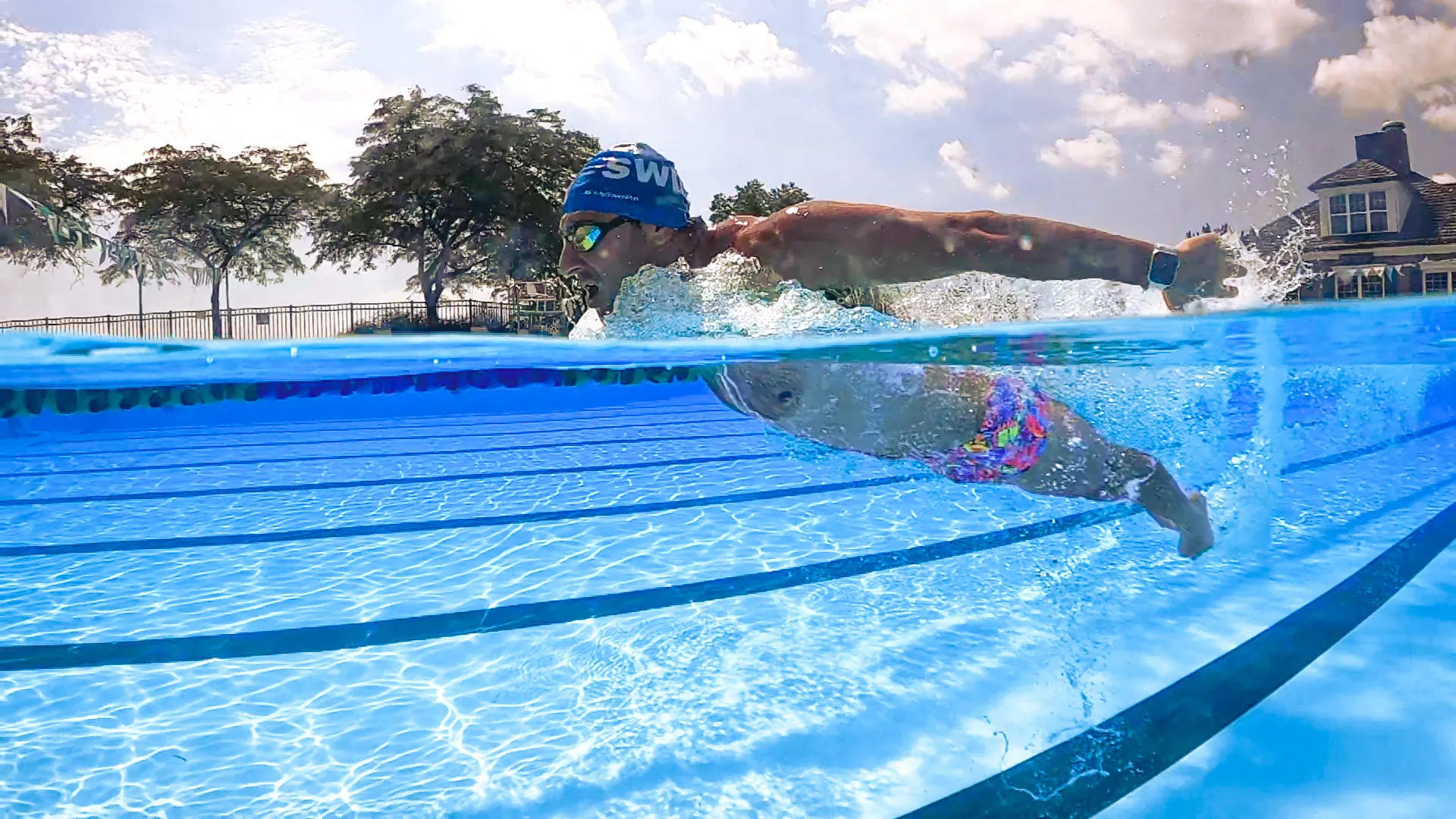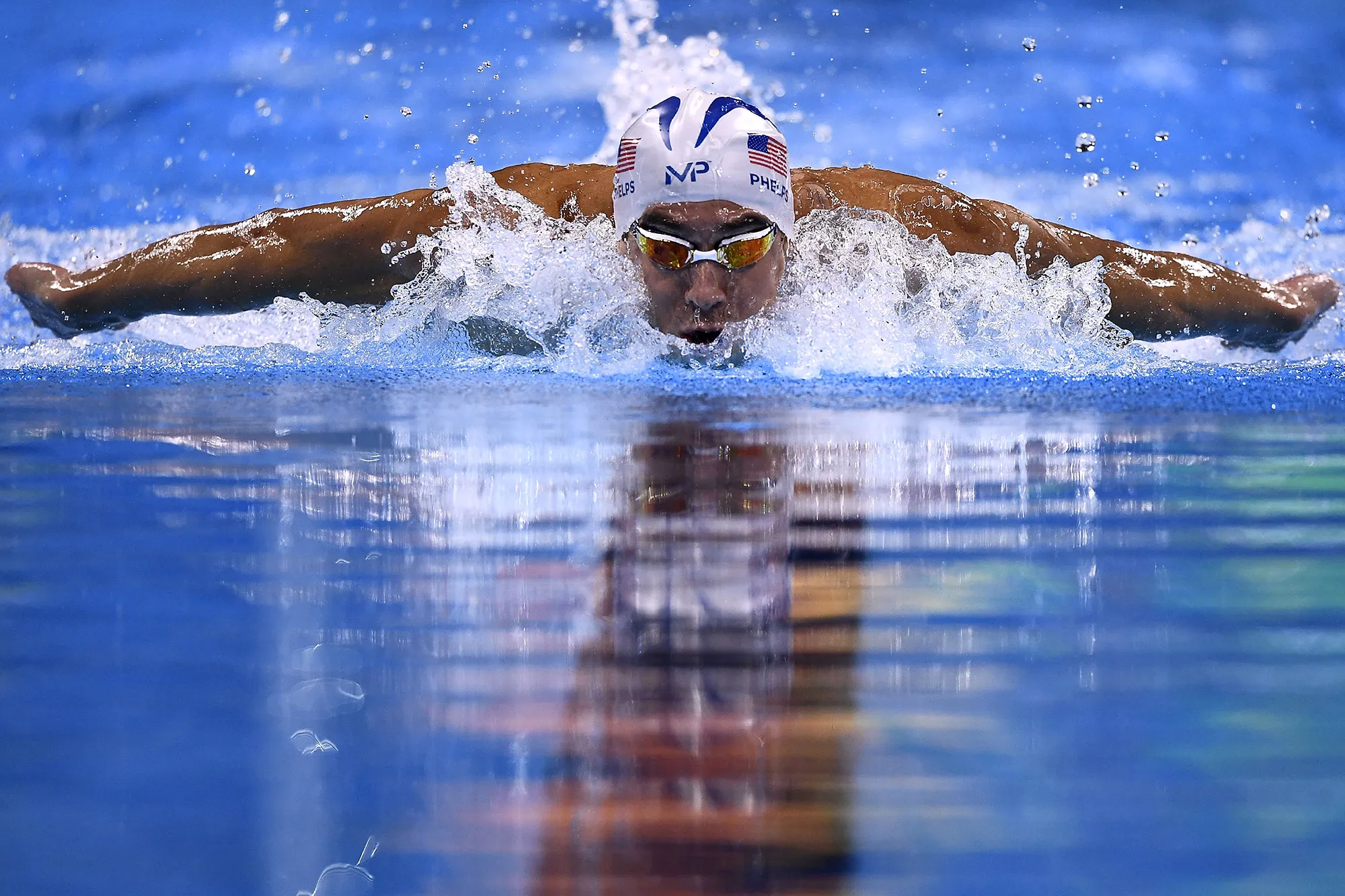Butterfly swimming is a highly specialized and challenging aspect of competitive swimming. Unlike the traditional butterfly stroke, this technique requires swimmers to propel themselves below the water’s surface, optimizing their hydrodynamic efficiency.
In this blog, Swim Time Log will share some information about mastering the basics of butterfly swimming for beginners. That technique brings significant advantages during starting and turning. That makes the difference between victory and defeat in fierce races.
Butterfly swimming technique in competitive swimming
Underwater butterfly swimming requires a combination of precise movements, breath control and extraordinary core strength to perform successfully. This technique becomes an essential skill for those who want to excel in swimming.

- Butterfly Stroke is a Important Component in Swimming Medley
Optimizing body position for superior swimming performance
Streamlined position with head aligned with spine
Aligning your body position for Butterfly Stroke
The key to successfully using the butterfly technique underwater is to position your body optimally. Swimmers need to keep their head in line with their spine and maintain a streamlined posture to improve hydrodynamic efficiency. Swimmers can move through the water more smoothly and with less resistance thanks to this alignment.
High hips in the water
Another key to successful underwater butterfly swimming is to keep your hips high in the water. By keeping the swimmer’s lower body in the water and reducing drag, this hip elevation maximizes forward propulsion. To achieve the slimmest figure possible and minimize energy loss, maintaining a straight and toned body contour is essential. This requires keeping the body straight and closing the arms to create powerful fish-like movements in the water.
Maintaining a straight and tight bodyline
Keeping a tight bodyline for Butterfly strokes
Swimmers can gain a competitive edge, improve their underwater butterfly technique, and achieve better overall performance in the sport by focusing on certain elements of body position.
Mastering leg action in butterfly swimming for beginner
Initiation of the dolphin kick from the core
Leg Techniques for Butterfly Swimming
Understanding the leg action is essential to swimming with efficiency and speed when using the underwater butterfly method. The dolphin kick starts at the swimmer’s core, where they produce the force for their kicks. Swimmers can create a firm foundation for a powerful and efficient leg movement by using their core muscles.
Bending knees slightly and rapidly snapping legs together
The quick snapping of the legs together after a quick and accurate bending of the knees is a crucial part of the leg action. In addition to providing propulsion, this motion aids swimmers in maintaining their forward momentum.
Kick originating from the hips, not the knees
It is vital to remember that the hips, not the knees, should be the main point of origin for the kick. This method makes sure that the power is distributed around the body in an effective manner, producing a smoother and more moving through the water with efficiency.
Quick and powerful motion
The ultimate goal for swimmers using the underwater butterfly method is a forceful and rapid leg action. With each stroke, swimmers are able to cover more ground because to this powerful kick. Leg action is a crucial component of training and race strategy for swimmers since it can greatly improve their performance and competitiveness in the pool.
The power of time in butterfly swimming
Body Coordination is Crucial in Butterfly Swimming
Coordinating leg action with arm movements
When learning the underwater butterfly swimming technique, timing is essential. Swimmers need to synchronize their arm and leg movements for optimal speed and efficiency. It need synchronization to pull off a fluid and potent stroke. In underwater butterfly swimming, time is important.
Initiating arm pull as legs snap together
Starting the arm pull at the same moment as the legs come together is essential. Swimmers can decrease needless drag in the water and maintain their forward propulsion at this exact time.
Maximizing efficiency and forward momentum
The key to mastering the underwater butterfly technique’s timing is to maximize forward motion and efficiency. Perfect timing allows swimmers to go through the water more quickly and with less resistance, which improves race times and gives them a competitive advantage . Any serious competitive swimmer who wants to be the best in the sport must master the timing of their strokes.
Breathing mastery in butterfly swimming for beginners
Guides to Breathing in Butterfly Strokes
Breathing not a part of the underwater butterfly swimming technique
It’s critical to realize that the underwater butterfly swimming method does not include breathing. When swimming the underwater butterfly technique, swimmers submerge themselves continuously without breathing underwater, in contrast to certain other swimming forms like freestyle or backstroke, when swimmers take regular breaths.
Taking breaths during the recovery phase when head comes out of the water
When swimming the underwater butterfly method, swimmers usually inhale when their head comes out of the water during the recovery phase. The swimmer’s head comes above the water at this point, giving them a minute to inhale before lowering it back into the water to keep their streamlined position. For swimmers to maintain their effort and energy levels throughout the race, proper breathing and timing are crucial.
Read more: Easy Butterfly Swimming Tips for Beginners
The importance of strategy and strength in butterfly swimming for beginners
Improving Strength in Butterfly Swimming for Beginners
Importance of practice and strength training
Strength training and consistent practice are essential for becoming proficient in the underwater butterfly swimming technique. Swimmers that compete know how important it is to put in the time and effort necessary to master this difficult ability. To build the muscle memory and coordination required to perform the technique well, practice is a must.
Building core strength, leg strength, and flexibility
Developing flexibility, leg strength, and core strength is essential for swimmers who want to be competitive in the underwater butterfly. A strong dolphin kick is made possible by strong legs, and a powerful stroke is built on core strength. Being flexible makes it possible for swimmers to keep their bodies in a streamlined position, which lowers resistance in the water.
Incorporating specific drills and exercises targeting the dolphin kick
Training for the underwater butterfly technique requires specific exercises and drills aimed at the dolphin kick.These drills assist swimmers in honing their leg action, enhancing the force and speed of their kicks, and ensuring perfect arm-to-leg synergy. Swimmers can improve their underwater butterfly performance and sharpen their competitive edge in the pool by putting a strong emphasis on practice and strength training.
Conclusion
In conclusion, the underwater butterfly swimming technique is a complex yet invaluable skill for competitive swimmers. The critical elements, including body position, leg action, timing, and breathing, must be mastered to maximize speed and efficiency in the water. Maintaining a streamlined position, coordinating leg and arm movements, and focusing on specific drills are all integral to success in this technique. It’s worth highlighting that adherence to rules and guidelines is crucial in competitive swimming.
Proper execution of the underwater butterfly technique, as well as other swimming styles, is not only about personal achievement but also about maintaining a fair and level playing field for all competitors. Following these rules ensures that the sport of swimming remains a test of skill, endurance, and dedication. Swimmers who commit to mastering the underwater butterfly technique and respecting the rules will find themselves well-prepared to succeed in the challenging and highly competitive world of swimming.
Explore other: Learn Butterfly Swimming Step by Step






AUTHOR
Sang Nguyen
Sang Nguyen is a former national swimmer for Vietnam who has transitioned into coaching. With a passion for fostering a healthy swimming community and connecting like-minded individuals,......Read More
BLOG
Maybe You Are Interested
Nutrition for Swimmers Guide: Maximizing Performance
Swimming demands not only physical prowess but also a strategic nutritional approach to maximize performance....
Crafting a Nutrition Plan for Competitive Swimmers
In the competitive world of swimming, nutrition plays a pivotal role in an athlete’s performance...
A Comprehensive Guide to Maximum Performance Nutrition for Swimmers
Swimming is not just about technique and training; nutrition plays a pivotal role in a...
Essential Swim Nutrition Tips for Peak Performance
Swimming is a highly demanding sport, requiring a combination of technique, strength, and endurance. But...
Expert Sports Nutrition Advice for Swimmers
In the competitive world of swimming, nutrition and training are as crucial as the technique...
The Synergy of Swimming and Nutrition: Balancing Intake for Optimal Water Performance
The Synergy of Swimming and Nutrition: Balancing Intake for Optimal Water Performance dives into the...